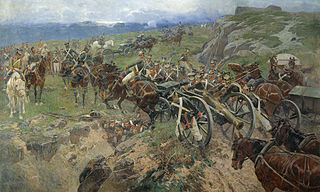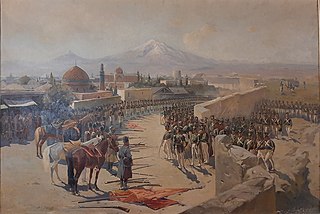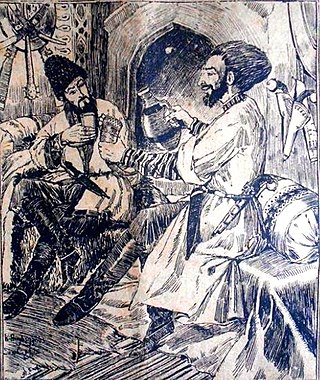Related Research Articles
The Russo-Persian Wars or Russo-Iranian Wars were a series of conflicts between 1651 and 1828, concerning Persia and the Russian Empire. Russia and Persia fought these wars over disputed governance of territories and countries in the Caucasus. The main territories disputed were Aran, Georgia and Armenia, as well as much of Dagestan – generally referred to as Transcaucasia – and considered part of the Safavid Iran prior to the Russo-Persian Wars. Over the course of the five Russo-Persian Wars, the governance of these regions transferred between the two empires. Between the Second and Third Russo-Persian Wars, there was an interbellum period in which a number of treaties were drawn up between the Russian and the Persian Empires, as well as between both parties and the Ottoman Empire. Ottoman interest in these territories further complicated the wars, with both sides forming alliances with the Ottoman Empire at different points throughout the wars. Following the Treaty of Turkmenchay, which concluded the Fifth Russo-Persian War, Persia ceded much of its Transcaucasian territory to the Russian Empire.

The Russo-Persian War of 1804–1813 was one of the many wars between the Persian Empire and Imperial Russia, and, like many of their other conflicts, began as a territorial dispute. The new Persian king, Fath Ali Shah Qajar, wanted to consolidate the northernmost reaches of his kingdom—modern-day Georgia—which had been annexed by Tsar Paul I several years after the Russo-Persian War of 1796. Like his Persian counterpart, the Tsar Alexander I was also new to the throne and equally determined to control the disputed territories.

The Ganja Khanate was a khanate under Iranian suzerainty, which controlled the town of Ganja and its surroundings, now located in present-day Azerbaijan.

The Shaki Khanate was a khanate under Iranian and later Russian suzerainty, which controlled the town of Shaki and its surroundings, now located in present-day Azerbaijan.

Shirvan Khanate was a Caucasian khanate under Iranian suzerainty, which controlled the Shirvan region from 1761 to 1820.
Ibrahim Khalil Khan Javanshir was the second khan of the Karabakh Khanate from the Javanshir family. He was the son and successor of Panah-Ali khan Javanshir.
Javad Khan ; c. 1748 – 1804) was a member of Ziyadoghlu Qajar, a clan of the Qajar tribe, as well as the sixth and the last khan of the Ganja Khanate from 1786 to 1804 before it was lost to Russia.

The Russian conquest of the Caucasus mainly occurred between 1800 and 1864. The Russian Empire sought to control the region between the Black Sea and Caspian Sea. South of the mountains was the territory that is modern Armenia, Azerbaijan, Georgia, and parts of Iran and Turkey. North of the mountains was the North Caucasus region of modern Russia. The difficult conquest of the intervening mountains is known as the Caucasian War. Multiple wars were fought against the local rulers of the regions, as well as the dominant powers, the Ottoman Empire and Qajar Iran, for control. By 1864 the last regions were brought under Russian control.
Fatali Khan or Fath Ali Khan of Quba was a khan of the Quba Khanate (1758–1789) who also managed to dominate the Derbent, Baku, Talysh and Shirvan Khanates, as well as the Salyan Sultanate during much of his reign.

Iulon was a Georgian royal prince (batonishvili) of the House of Bagrationi, born into the family of King Heraclius II and Queen Darejan Dadiani. He advanced claim to the throne of Kartli and Kakheti after the death of his half-brother George XII in 1800 and opposed the Russian annexation of Georgia until being apprehended and deported in 1805 to Tula. He died in St. Petersburg and was buried at the Alexander Nevsky Lavra.
Shahverdi Khan Ziyadoghlu was the beylerbey of Karabakh from 1740 to 1743 and first khan of Ganja from 1747 to 1760. He was from the Ziyadoglu branch of the Qajar clan who ruled the Beylerbeylik of Karabakh as hereditary governors.
Rahim Khan was the fifth Khan of Ganja, who ruled only briefly in 1786.
The House of Sarkar was a ruling clan of the Shirvan Khanate from the Khanchobany tribe. "Sarkar" means "tax collector," which hints at the profession of an early progenitor.
The Khoy Khanate, also known as the Principality of Donboli, was a hereditary Kurdish khanate around Khoy and Salmas in Iran ruled by the Donboli tribe from 1210 until 1799. The khanate has been described as the most powerful khanate in the region during the second half of the 18th century. The official religion of this principality was originally Yezidism, until some rulers eventually converted to Islam. The principality has its origins under the Ayyubid dynasty and was ultimately dissolved in 1799 by Abbas Mirza. During this period, the status of principality oscillated between autonomous and independent.

The region of Talish was a governorate of Safavid Iran (1501–1736), located in the greater Talish, presently divided between Iran and Azerbaijan. The territory of the governorate was principally made up of the two subordinate governorates of Astara and Lankaran. The city of Astara was its administrative center, the base of Safavid power in the region.

Umma Khan V Avar nicknamed Great or Mad — Avar nutsal, ruler of Avar Khanate from 1774 to 1801. Under Khan, the Avar Khanate expanded its borders both by subordinating the Avar free societies, and at the expense of neighboring territories. Khan was paid tributes by the Georgian king Erekle II, Derbent, Quba, Baku, Shirvan, Shaki khans and Akhaltsikhe pasha.
Muhammad Khan, Mammad Khan or Muhammad II of Ganja (1738–1780) was the third Khan of Ganja from 1768 to 1780 from the Ziyadoglu branch of the Qajar clan who ruled the Beylerbeylik of Karabakh as hereditary governors.
Ughurlu Khan or Oghurlu Khan was a claimant to Khanate of Ganja and a member Ziyadoghlu Qajar, a clan of the Qajar tribe.

Mehtuli Khanate, or otherwise known as Dzhengutai Khanate was a Kumyk state in Dagestan that existed in the 17th–19th centuries.
Hoseyn Ali Khan was the khan (governor) of the Erivan Khanate from 1759 to 1783 and brother of the previous Hasan Ali Khan.
References
- ↑ Akopyan, Alexander V (Autumn 2008). "Ganja Coins of Georgian Types, AH 1200–1205" (PDF). Journal of the Oriental Numismatic Society. 197 (Supplement: Caucasian Numismatics, Papers on the Coinage of Kartl-Kakheti (Eastern Georgia), 1744–1801): 47–52. Archived from the original (PDF) on 2013-12-11.
- 1 2 Butkov, Pyotr (1869). Материалы для новой истории Кавказа, с 1722 по 1803 год[Materials for the new history of the Caucasus, from 1722 to 1803] (in Russian). Saint Petersburg. p. 159.
{{cite book}}: CS1 maint: location missing publisher (link) - ↑ Babayev, Elgun (2003). Из истории Гянджинского ханства [From the history of the Ganja Khanate](PDF) (in Russian). Baku: Nurlan. p. 29.